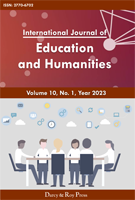Study on the Interactive Pathways of Improving Middle School Students' Sense of Learning Efficacy and Teachers' Sense of Teaching Efficacy
DOI:
https://doi.org/10.54097/rjazqq46Keywords:
Middle School Students' Learning Efficacy, Teachers' Teaching Efficacy, Interactive Pathways, Social Cognitive Theory, Teaching PracticeAbstract
Learning efficacy is a middle school student's subjective judgment of their own learning ability based on past learning experiences, which directly influences their learning motivation, persistence, and academic performance. Teaching efficacy, on the other hand, is a teacher's belief in their ability to effectively complete teaching tasks and promote student development, and is the core driving force behind their professional behavior. In current middle school education, some middle school students experience a weakening sense of learning efficacy due to increasing subject difficulty and academic setbacks. Teachers, on the other hand, often face fluctuations in their sense of teaching efficacy due to teaching pressure and student management challenges. The negative interaction between the two has become a significant factor hindering the improvement of teaching quality. This paper draws on Bandura's social cognitive theory of "self-efficacy" and "tripartite interactive determinism" as its core theoretical foundation. Integrating survey data on middle school student and teacher efficacy published in journals such as Educational Research and Psychological Development and Education, this paper systematically explores the bidirectional influencing mechanisms between middle school students' learning efficacy and teachers' teaching efficacy through literature analysis, theoretical integration, and practical case studies. It identifies actionable interactive pathways, including classroom feedback, post-class dialogue, and community building, and constructs a collaborative support and guarantee system among schools, families, and society. This study aims to provide theoretical references and practical strategies for middle school education practice, helping to break the negative cycle of teacher-student efficacy and achieve a synergistic improvement in middle school students' learning efficacy and teachers' teaching efficacy, ultimately promoting students' well-rounded development and teachers' professional growth.
Downloads
References
[1] Guo Ting. Research on strategies to improve primary school Chinese teachers’ teaching efficacy[D]. Sichuan Normal University, 2020.DOI:10.27347/d.cnki.gssdu.2020.000117.
[2] Wang M, Zhang L J. Understanding teachers' online professional learning: A “community of inquiry” perspective on the role of Chinese middle school teachers’ sense of self-efficacy, and online learning achievement[J]. Heliyon, 2023, 9(6).
[3] Shachar H, Shmuelevitz H. Implementing cooperative learning, teacher collaboration and teachers’ sense of efficacy in heterogeneous junior high schools[J]. Contemporary educational psychology, 1997, 22(1): 53-72.
[4] Wolters C A, Daugherty S G. Goal structures and teachers' sense of efficacy: Their relation and association to teaching experience and academic level[J]. Journal of educational psychology, 2007, 99(1): 181.
[5] Han Ruimiao, Xu Chunfei. The intervention effect of mindfulness-based cognitive therapy on middle school students’ learning efficacy under the background of “double reduction” [J]. Educational Measurement and Evaluation, 2022, (02): 103-112. DOI: 10.16518/j.cnki.emae.2022.02.012.
[6] Sun Xinyu. Research on strategies to improve junior high school students’ learning efficacy under the perspective of positive personality education [D]. Harbin Normal University, 2019.
Downloads
Published
Issue
Section
License
Copyright (c) 2025 International Journal of Education and Humanities

This work is licensed under a Creative Commons Attribution 4.0 International License.

















